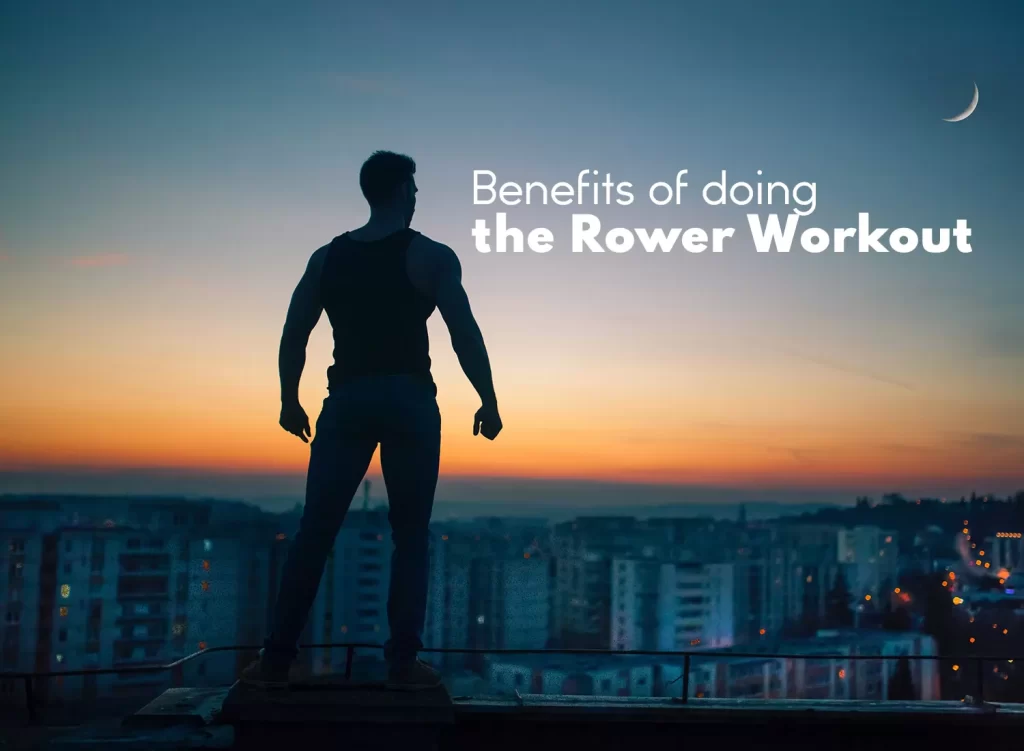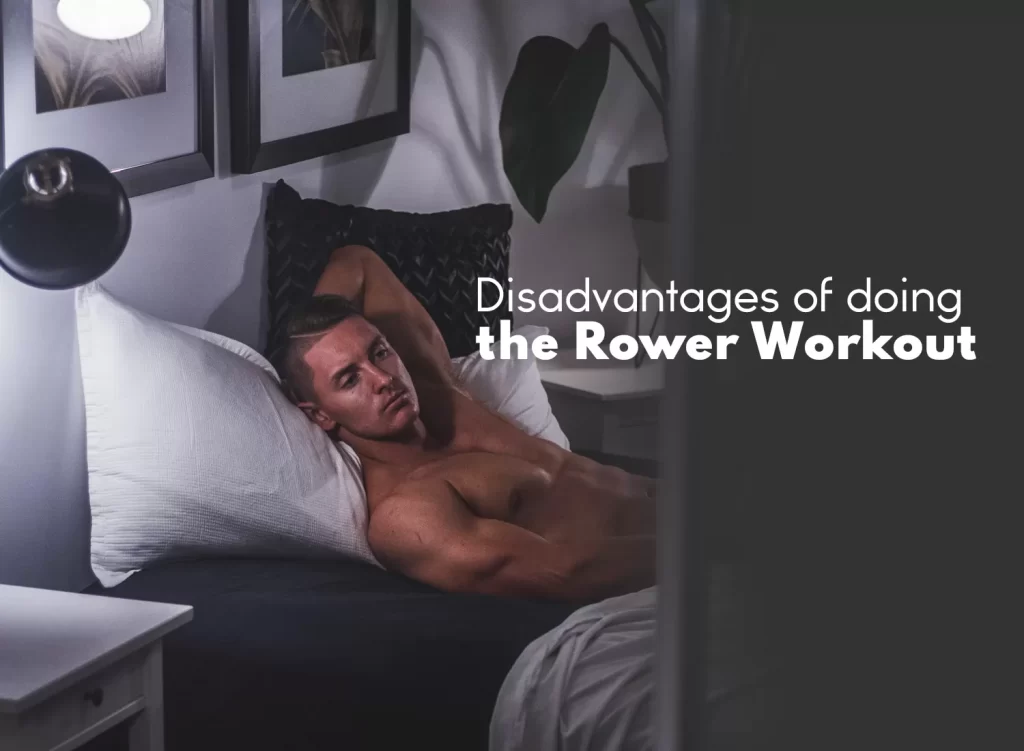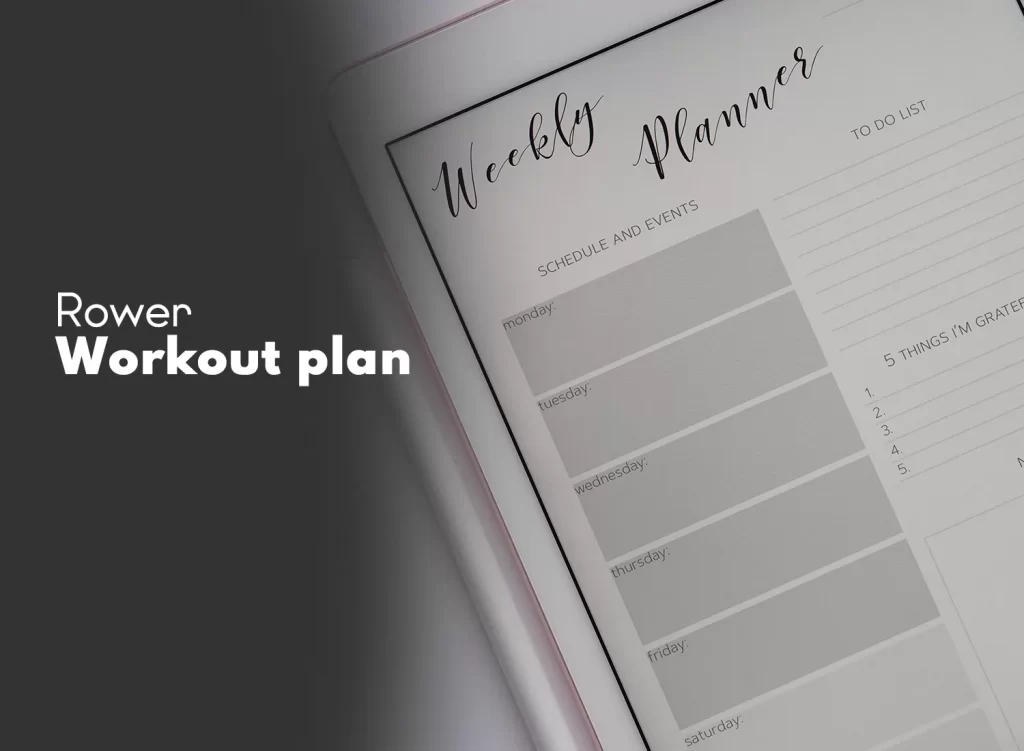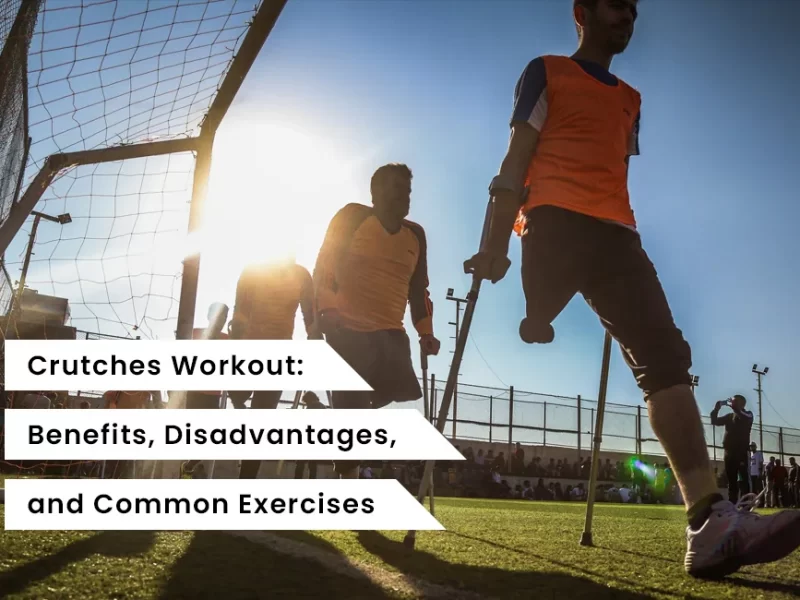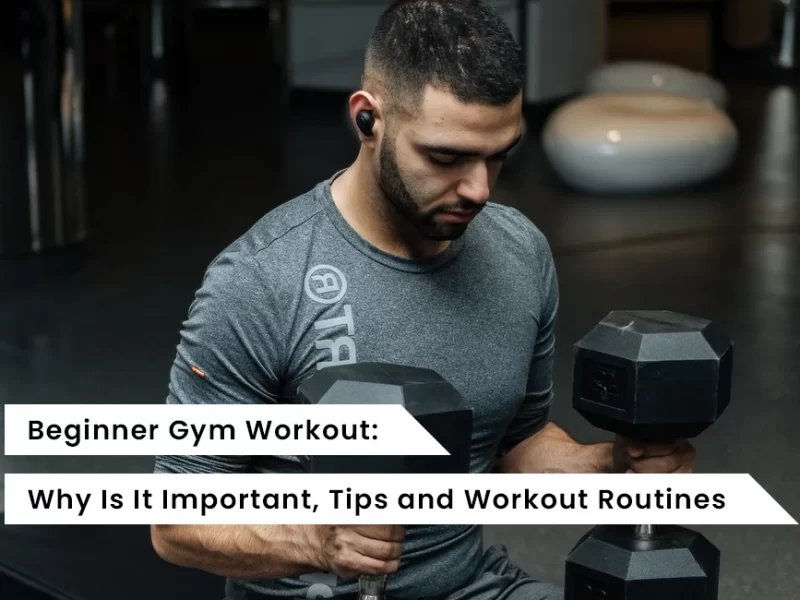Table of Contents
The Rower Workout is a full-body workout that uses a rowing machine to provide resistance. The rowing machine is an excellent piece of equipment for cardio and strength training, as well as rehabilitation. Rowing is a full-body workout that strengthens your core, back, arms, legs, and more. It’s also low-impact and easy on your joints. Learn how to row at home with this beginner’s guide to rowing.
What is Rower Workout?
Rower Workout is a type of aerobic exercise that uses a rowing machine to provide resistance.
It was first used in the 1920s by the English physical education professor Frank Horwill and his colleagues as an alternative form of exercise for rowers. Rowing machines work by using a flywheel to create resistance, which is then converted into rotational movement by a belt or chain. The flywheel stores kinetic energy and releases it when needed to produce more power.
Rowing is a full-body workout that can be done by most people. The rower works the arms, back, and legs while also engaging the core and chest muscles.
The rower needs to keep their back straight and lean forward with their elbows bent at 90 degrees. This will push the handles of the rowing machine towards your stomach or chest.
The rower then pulls on the handles of the machine to return to an upright position with their arms fully extended in front of them with palms facing clenbuterol before and after down on either side of the handlebar.
Rower workouts are a great way to burn fat and calories. They are also a good workout for the whole body, which is why they are so popular.
Benefits of doing the Rower Workout
Rowing machines provide many benefits such as improved cardiovascular fitness, increased muscle strength and endurance, weight loss, and improved mental health.
It’s a common misconception that rowing works only with your arms. In reality, rowing is a full-body workout.
The major muscle groups it targets are your:
- quadriceps
- calves
- glutes
Rowing also helps with strengthening your upper body, including:
- pecs
- arms
- abdominal muscles
- obliques
Your leg muscles are primarily engaged during the drive part of the stroke, or when pushing off the foot stretcher.
Also, here are the main benefits of doing Rower Workout
It is good for people of all fitness levels to try
As long as you have an ergometer, you can add rowing to your workout.
This exercise has also been deemed safe for low vision and blind individuals.
A 2015 study including 24 people with low vision found that rowing 5 days a week for 6 weeks led to a significant decrease in fat mass and total body fat percentage.
Additionally, the participants’ cholesterol levels decreased and their back strength and trunk flexion increased significantly.
It’s low impact
Rowing is a low-impact and effective way to burn calories. It also allows you to control the movement and pace which can be great for active recovery.
It’s sometimes recommended as an exercise option for people with early stages of osteoarthritis.
The same can’t be said for high impact exercises such as running and plyometrics.
Rower Workout can be meditative
There’s a mind-body connection with rowing.
While you might find the most calming benefits by rowing outside on the water, you can still achieve some level of this indoors.
This comes from the smooth, gliding motion you can create on the ergometer and the repetitive movements that allow your mind to go on autopilot.
This involves the four phases of the row stroke, which are the:
- catch
- drive
- finish
- recovery
Rowing also promotes the release of endorphins, which are those feel-good hormones that reduce stress.
Rower Workout is great for your heart and lungs
As a cardio exercise, rowing can build your cardiovascular system which includes parts such as your heart and blood vessels. This system is responsible for transporting important materials such as nutrients and oxygen around your body.
Since rowing is such an intense workout, your heart has to work hard to transport more blood to your body. This can improve heart strength.
This may be beneficial for those who have or could be at risk for heart problems.
Rower Workout builds power and endurance
Rowing can increase your cardiovascular fitness as well as building muscle strength.
Power is your ability to exert maximum force in a very short amount of time — think jumping, accelerating to a sprint, or hitting a punching bag or a baseball.
If you row correctly then you are using a balance between arm and leg power in order to propel your body forwards.
Endurance is your body’s ability to sustain an activity, like rowing, for an extended period of time. Rowing checks off both forms of endurance — cardiovascular and muscular.
Rower Workout is efficient
Even if you’re short on time, the rower can help you reach your goals.
Since it’s a full-body workout, you’ll hit the major muscle groups and get both a cardio and strength workout.
Plus, short bursts of intense exercise, like high intensity interval training (HIIT), are known to increase cardiac function and excess post-exercise oxygen consumption. In other words, you’ll burn more calories after your workout is over.
A recent study found that low volume HIIT — less than 15 minutes per session — can induce similar, or even greater, improvements in fitness level, glucose control, blood pressure, and cardiac function than high volume HIIT or moderate-intensity continuous training (6Trusted Source).
Rower Workout is a great alternative to the treadmill or elliptical
When it comes to exercise machines at the gym, you may overlook the rowing machine at first.
However, this may change once you compare it to other exercise machines, such as the treadmill and the elliptical.
For example, the treadmill focuses mainly on your lower body, while the ergometer provides a full-body workout.
While the rowing machine and elliptical both work the upper and lower halves of your body, the rowing machine requires more effort in your upper body and abs with each stroke.
Also, if you live in a condo or apartment with neighbors below you, a rowing machine is much quieter than a treadmill. Rowing machines also tend to be more affordable than treadmills.
The machine is home workout-friendly
A treadmill or weight rack setup can take up quite a bit of space in the average home gym, especially if your living room is also used as your workout space.
See also The Ultimate Guide to Ryan Reynolds’ Workout: What to Know and What to Do
Disadvantages of doing the Rower Workout
The rower is a great cardiovascular workout machine. It has been shown to improve cardiorespiratory fitness, increase muscular endurance and strength, and decrease body fat. However, there are some disadvantages to the rower that need to be taken into consideration before purchasing one.
A toll on the lower back
Before using a rowing machine, you want to make sure you read the instructions carefully. Failure to follow instructions can lead to injuries or improper form.
Once you begin, you want to start slow. Avoid going too quickly because this can put a substantial strain on your lower back.
In general, rowing may not be advised if you suffer from a history of chronic back problems.
With rowing, you’re pulling a cord toward you while moving into an upright position. Then, you let the machine bring the cord back away from you.
In some people, this can put a toll on the lower back. As such, it’s not recommended for people with a history of spine or back problems to start rowing.
A lot of noise
Another thing to bear in mind is that rowing machines can be rather noisy.
This is especially true for air and water rowers. Every time you pull back, the machine makes a loud noise.
As a result, it may not be ideal if you live in an apartment or small house with other people. They may quickly get aggravated every time you try to work out because you’re making so much noise and are taking up valuable space.
It doesn’t mean you have to completely disregard rowers. You can consider how often other people are in your home and when you would have some alone time with the rowing machine.
A lot of space
Even if you work around the noise issue, there’s the matter of space.
Again, people who live in an apartment or small house may find it difficult to find a good area to keep the rowing machine.
These devices have a big tank or flywheel in addition to tracks that take up a fair amount of your home gym.
Fortunately, there can be a workaround for this.
Many rowing machines on the market are now foldable or collapsible. You fold it out when you need to work out, and then fold it back when it’s not in use.
You can move it to the center of the room when you want to work up a sweat and put it away in a closet or in the corner when you’re done.
Of course, the space and noise of a rowing machine won’t be an issue if you simply use them at the gym.
Can be boring
Like running, rowing is an ultra-repetitive movement.
You sit, pull, and return. Sit, pull, return.
You do this over and over and over, sometimes for an hour or more on end and that’s rowing.
So you’re stuck in the gym or living room doing the same thing over and over.
You can mix up your rowing workouts by creating or following HIIT routines involving the rower.
When you combine rowing with other forms of cardio, HIIT, and weight lifting, you’ll see great results.
However, be aware, a bland routine may seem like it’s working in the beginning but over time it can be difficult to maintain.
Things to remember before doing the Rower Workout
Rowing is a sport that is becoming more and more popular. It is good for the cardiovascular system, and it can also be done by people with different fitness levels.
Some tips to remember before starting rowing are:
Wear clothes that won’t get in the way of rowing
Your best bet would be either compression gear or anything relatively form fitting. Baggy sweatpants could weigh you down or interfere with your motion on the machine.
As for shoes, go with a cross-training sneaker that’s not heavily cushioned or bulky. We recommend wearing more of a cross-training shoe, so you don’t have a ton of lift in your heel. Because you aren’t pounding the pavement, you don’t need to have as much support as a running shoe.
Check your resistance settings
Just like an indoor cycling bike, rowing machines have settings that allow you to increase or decrease resistance to make it easier or more difficult to row. Throw it up to the highest setting and it’ll feel like you’re rowing through sludge and make it hard to generate momentum. The minimum setting will feel like there’s no resistance at all.
A rowing machine that’s powered by a wheel will have a lever or knob that’s numbered from 1 to 10, with 1 being the lowest resistance and 10 being the highest. When you change the setting, it changes how much air flows into the internal wheel (the more air, the more resistance you have to work against). If you’re using a water rower (some newer boutique studios have them), there won’t be a resistance setting. Resistance changes depending on how fast or slow you’re rowing, so you’ll likely need to do some trial and error to get a feel for how it works.
Maintain proper posture
Not only will good posture help protect you from strain and injury, it will also help you generate power properly. Sit tall, relax your shoulders, and keep your core engaged. When rowing, think about the same things when holding a plank: Your spine is long and your abs are tight. Without proper posture, you’ll experience lower-back pain.
Also, make sure your butt is toward the front edge of the set, which will help you maintain good posture. If you’re having lower-back pain, double-check your posture and make sure you are holding your abs tight. Hunching and rounding your shoulders forward can also cause discomfort in your upper back, so pay attention to that, too.
Pay attention to how you grip the handle
You should hold the handlebar (with your palms facing down) firmly, but not like you’re holding on for dear life. Try to keep your forearms relaxed. If you grip too tightly, you’ll probably tire out your forearms quickly.
When sitting up with nice posture and holding the handle bar out straight, try to keep the bar at that level as consistently as possible. Then, focus on steady strokes.
Aim for full strokes and a steady rhythm
Your rowing motion should be smooth and consistent. A key way to think about rowing is that each stroke is 60 percent legs, 20 percent core, and 20 percent arms. If you’re rowing right, you should feel your glutes, lats, and scapula muscles engage with each stroke.
Start with your knees bent, weight in the balls of your feet, butt by your heels, arms extended and gripping the handle. Whenever you are in this knees-bent position (called the catch), you want your arms to reach just beyond your feet. You should be sitting tall, torso leaning slightly forward. Then, roll your feet so you are pushing with your entire, flat foot and extend your legs, sliding your butt back and pulling the handle toward your chest. When your legs are fully extended in the stroke, lean your torso back just enough to feel your abs engaged, and you’ll have perfect motion. Then, bend your knees and bring your body forward to return to the starting position.
Think about generating power from your legs
Although your arms are helping you out, your legs are doing most of the work in a rowing workout. And that’s why your legs and butt will totally be on fire. At the start of the stroke, your calves, hamstrings and glutes are loaded up. As the legs start to press, the body generates momentum for the body and arms to finish carrying through.
At the end of about 10 minutes, you’ll probably feel a good burn on your butt, your legs, and your core.
Rowing workouts are typically interval based. The classic rowing interval is 500 meters mainly because it’s 1:45 to 2:30 minutes, which is a reasonable amount of time to push yourself and be able to replicate after a minute of resting.
Some workouts may also be based on the number of strokes. For example, the instructor may tell you to do 10, 20 or 30 strokes as hard as you can before you stop and recover. You may also get off the rower and do other workouts as recovery, like lunges, squats, and planks. You can also do more endurance-based workouts by repeating intervals over 1,000 meters or over 3 to 4 minutes long with recovery. These will focus more on longer, steady strokes rather than faster “sprints” for extra cardio.
See also Crutches Workout: Benefits, Disadvantages, and Common Exercises
You might be sore after your first couple classes.
If you’re new to rowing, you’re bound to feel sore after your first class (or even after a few classes). Delayed-onset muscle soreness (DOMS) is really common when you’re doing a brand-new workout and challenging your muscles in ways they aren’t used to.
While there’s unfortunately no way to cure DOMS, you can try to ease the tightness with some foam rolling or do some easy cardio to improve circulation in the area and give your recovery a little boost.
You can take a brisk walk, head to the treadmill for a jog, or try some yoga and stretching—all of which will help you find a bit of relief as you wait for your muscles to recover and the soreness to subside.
Rower Workout plan
A rowing workout plan can vary depending on the intensity of the exercise session. Here are some rowing exercises that you can work into your routine:
Water Rower
If you are a complete beginner, row on low resistance (i.e., 2 or 3) for three to five minutes. If you have a medium level of fitness you might extend the time to ten or fifteen minutes. If you are very fit, you might row for fifteen to thirty minutes. When starting out, shorter sessions more often are better than one longer session.
Row at an easy pace with a smooth stroke rate of eighteen to twenty-two strokes per minute. Take a few weeks to reach a comfortable speed for you. Use a heart rate monitor to monitor intensity.
Focus on good posture. Regulate ratio and rhythm. Make sure you pass through all the checkpoints. Practice your slide drill. Take twice as long to slide forwards on recovery compared to the drive back.
Always allow time for a cool down and stretch period after each rowing workout.
A good beginner schedule is three to four workouts the first week.
Pulley rows
These exercises are done with a machine or cable apparatus. You stand in front of the pulley with both feet on the ground, knees slightly bent, and grasp the handles with both hands. Pull your elbows back as if you were trying to touch them together behind your back. Return to starting position by releasing tension on the cable or machine handle before pulling again. Repeat for desired number of repetitions or time period.
Steady Rowing
Good for warming up, cooling down and beginners. Steady rowing is an easy-paced workout at around 18 to 24 strokes per minute (known as the rating). This is fine for a comfortable workout if you’re a beginner, and can also be used as a warm-up at the lower stroke rate before a vigorous session. Note: this isn’t so good for fitness and weight loss – see below for better options.
The Thousand-Meter Meltdown
This workout involves rowing long and fast. It also requires perfect rhythm and form. Increase and decrease the strokes per minute for each set.
Warm up for five or ten minutes. Set the level to medium. Do three sets of thousand-meter rows. Maintain 28 strokes per minute on the first set. Take a four-minute break. Do 24 strokes per minute for the second set. Take a four-minute break. Complete the third set at 26 strokes per minute. Warm ups, Cool downs and Stretches To avoid injuries it is important to do warm ups, cool downs and stretches.
How long should you do a Rower Workout
Rowers are an excellent cardio workout that can be done at home or in the gym. The duration of a rower workout is highly dependent on the intensity of the rowing machine.
The recommended time for a rower workout depends on how intense it is. If you are doing a low-intensity rowing workout, then you should do it for around 30 minutes. If you are doing a high-intensity rowing workout, then you should do it for around 10-20 minutes.
Is Rower Workout safe to do?
The answer is yes. Rowing is a low-impact, low-stress workout that can be done by people of any age and fitness level.
Rowing machines are usually made of aluminum or steel, which means they can create a lot of noise when in use. However, some rowers have been designed to be quieter than others.
If you are not used to rowing, your back and arms may get sore the first few times you try it. This is normal! If discomfort persists or becomes unbearable, stop rowing and consult your doctor.
A rowing machine provides an upper and lower body workout that will help you lose weight and gain muscle tone in all the right places without putting too much stress on your joints.
Summary and Conclusion
Rowing machines are one of the best cardio exercises you can do because they work your entire body. You use your arms, back, and legs to row the machine. The best part is that you don’t need any special equipment or a gym membership to do them. All you need is a rowing machine and some space, and you’re ready to go!
There are many benefits of doing rowing workouts. Not only will it help you lose weight but it will also improve your cardiovascular health, strengthen your muscles, and improve your balance. It’s also low-impact so it won’t put too much stress on your joints like running does.
Always consult your physician or doctor before beginning any new exercise regimen. Since only your doctor or physician can determine whether it is right for your needs. Knowing whether you are medically able to participate and how much exercise is safe for you is essential to prevent you from damages or injuries.
Now that you know the details of rowing machines as well as tips for performing workouts, go get a rowing machine and start reaping the benefits of rowing machine workouts practice your rowing exercise.
See also Protein After Workout: Why Is It Important, What Are the Benefits, and Disadvantages

